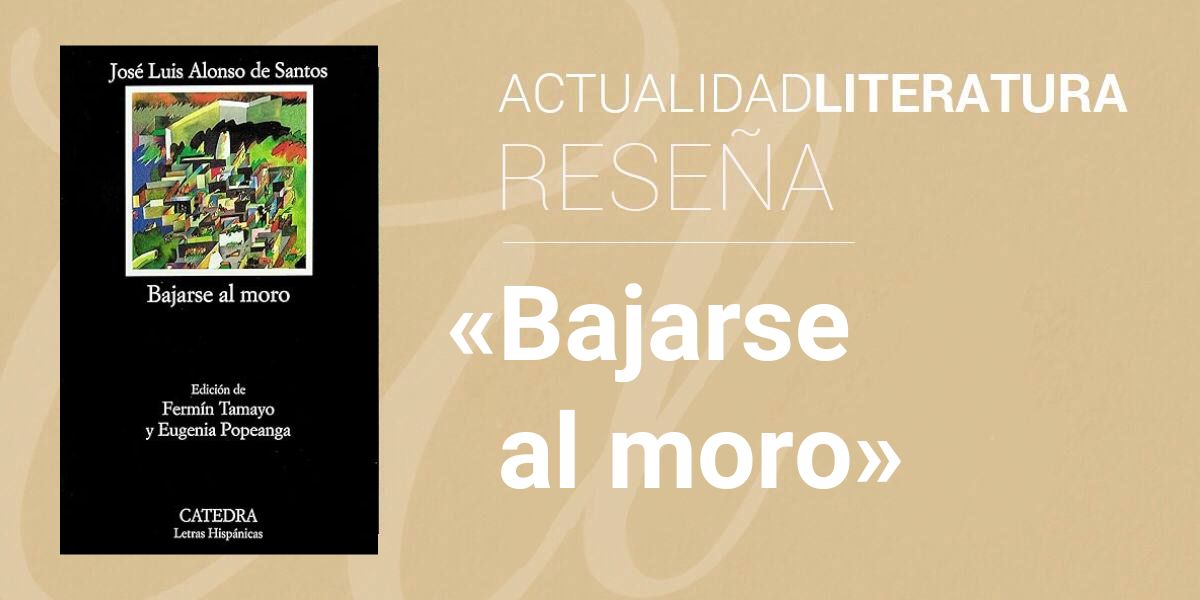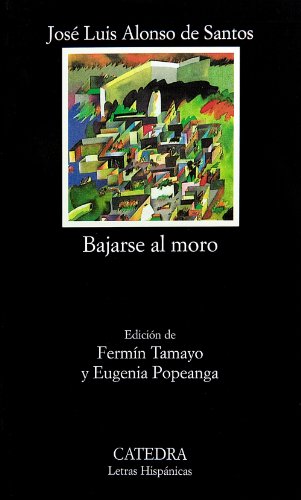
Bajarse al moro
Bajarse al moro is a comedy in two acts written by the Spanish actor, stage director, screenwriter and playwright José Luis Alonso de Santos. This work was premiered for the first time on April 6, 1985, at the Teatro Principal in Zaragoza, in a production by Justo Alonso. It was later performed at the Fuencarral Theater in Madrid in September 1985.
That year, the direction was directed by Gerardo Malla, who worked with actors such as Verónica Forqué, Jesús Bonilla, Pedro Mari Sánchez, Amparo Larrañaga and María Luisa Ponte. In 1987, The play was broadcast on Spanish Television with the same cast. Although the cast changed over time, the play remained in theaters until 1988.
Synopsis of Bajarse al moro
About the beauty of street language
The work follows the same line of manners as José Luis Alonso de Santos developed in his also outstanding Vallecas tobacconist, which is heir to the sainetes of the early 20th century. The idea of this production was to satirize the culture of traditional Madrid, which was populated by endearing characters and losers who were looking for the best way to survive in the neighborhood.
Due to its historical, economic and social context, this cast of people exhibits the live language of the street, the marginal slang of a part of the youth and colloquial speech. That is how The work gives rise to a rich range of phonetic, linguistic and syntax possibilities, which accompany a funny and ironic behavior, which, in turn, is filled with bitterness.
Through the entanglements
The story focuses on Chusa and Jaimito, two cousins who share a small apartment in Madrid., where they also live with another friend, Alberto. At some point, Chusa invites Elena, a friend of hers, to live with them. However, the hostess asks her new roommate to travel to Morocco with the intention of trafficking some drugs that were supplied to them.
The problem is that Elena is a virgin, so she cannot insert the merchandise into her vagina to transport it. So, they decide that the best solution is for the girl to lose her virginity to Alberto, because Jaimito was completely ruled out after planning. Even so, there are many difficulties that put the procedure in check, especially on the part of some characters.
outcome of Bajarse al moro
Doña Antonia, Alberto's mother, often interrupts her son and Elena's advances, so, in the end, Chusa travels alone to Morocco. Nevertheless, During her return to Madrid she is arrested and imprisoned. After leaving prison, he finds out that Alberto and Elena went to live together in Móstoles. Shortly after, Chusa discovers that she is expecting Alberto's baby, although she never tells him.
Structure of the work
Bajarse al moro consists of two acts: the first is divided into four scenes which last two days. The second is fragmented into three scenes, in which the number of days that elapse is not specified, so weeks or months could pass between the first and third performance.
Other representations of Bajarse al moro
In 1998, Fernando Colomo directed a film adaptation of the work of José Luis Alonso de Santos. Later, in 2008, it was released again in ,, this time, under the direction of its own author, who had the collaboration of authors such as Charo Reina, Alfonso Lara, Cristina Urgel, Alfonso Begara, Raquel Guerrero and Fernando Vaquero.
Awards awarded to Bajarse al moro
In 1986, the author won the National Theater Award and the Tirso de Molina Award, in addition, Gerardo Malla was awarded the El Espectador y la Crítica theater award for best stage direction. On the other hand, in 1987, José Luis Alonso de Santos was awarded the Mayte Theater Prize. The same year, actress Natalia Dicenta received the Ercilla Award for best female performance.
Reviews of Bajarse al moro
For many Spaniards, Bajarse al moro It is a play that they had to read during their high school days, a time when, perhaps, they could not fully enjoy it, given the language of the text and the complexity shown in the scenes. Even so, most critics have stated that this title is dynamic and effective, and has managed to stand the test of time.
From a show point of view, The performance tends to leave a rewarding feeling in the viewer's mind. Finally, within the literary context, Bajarse al moro It does not present a major challenge, but it is still an entertaining work, capable of making readers laugh and lighten their day.
About the Author
José Luis Alonso de Santos was born on August 23, 1942, in Valladolid, Spain. He graduated in Philosophy and Letters from the Complutense University and from the Faculty of Information Sciences. She began to be interested in the world of theater in 1960, during which year she received classes from William Layton at the TEM. Her first important encounter with this art was in Process by the shadow of a donkey (1964-1965).
He participated as an actor in this play. Likewise, he was one of the founders of the Tábano group and collaborated with the Independent Experimental Theater. In parallel to this project, In 1971 he founded the Teatro Libre group, which he led until its dissolution ten years later.. His first premiere as an author occurred in 1975 with Long live the Duke, our owner!
Premiered theater pieces by José Luis Alonso de Santos
- The fight between Don Carnal and Doña Cuaresma (1977);
- The true and unique story of the princess and the dragon (1978);
- From the labyrinth to 30 (1980);
- Vallecas tobacconist (1981);
- The family album (1982);
- Golfus Emerita Augusta (1982);
- The Roman (1983);
- kisses for sleeping beauty (1984);
- The last pirouette (1986);
- out of my mind (1987);
- Pairs and Nines (1989);
- The fight between Don Carnal and Doña Cuaresma (1989);
- Long live the opera! (1989);
- bird trap (1990);
- Fresco paintings of love and humor (1990);
- Vis a vis in Hawaii (1992);
- Our kitchen (1992);
- Tell him with Valium (1993);
- The shadow of Tenorio (1994);
- Visiting time (1994);
- Junkies and Yankees (1996);
- Wild (1997);
- The Buscón (1999);
- The comedy of Carla and Luisa (2003);
- a lucky man (2003);
- I, Claudio (2004);
- Long live the theater! (2006);
- The Generals' dinner (2008);
- In the dark heart of the forest (2009);
- The arrival of the barbarians (2010);
- Ten euros a glass (2012);
- San Felipe's janitors (2012);
- It's war!!! (2013);
- In the hands of the enemy (2013);
- The cultural week (2016)
Published theater pieces
- Long live the Duke, our owner! (1975);
- The fight between Don Carnal and Doña Cuaresma (1980);
- The true and unique story of the princess and the dragon (1981);
- The family album (1982);
- The last pirouette (1987);
- Vallecas tobacconist (1982);
- From the labyrinth to 30 (1985);
- Bajarse al moro (1985);
- out of my mind (1985);
- Pairs and nines (1990);
- bird trap (1991);
- kisses for sleeping beauty (1994);
- Vis a vis in Hawaii (1994);
- The shadow of Tenorio (1995);
- Visiting time (1996);
- Junkies and Yankees (1997);
- My versions of Plautus: Amphitryon, Casina and Miles gloriosus (2002);
- The comedy of Carla and Luisa (2003);
- short theater (2005);
- Paintings of love and humor, fresh (2006);
- In the dark heart of the forest / Our kitchen (2015);
- Microtheater (2016)
Narrative
- Landscape from my bathtub (1992);
- One of pirates! (2003);
- The leap child (2015);
- ghosts and the moon (2016)
Test
- Spanish theater of the 80s (1985);
- dramatic writing (1998);
- Manual of Theater Theory and Practice (2007)
Television scripts
- Eve and Adam, marriage agency (1990)
